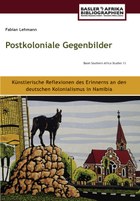-
 Postkoloniale Gegenbilder
Postkoloniale Gegenbilder
-
Künstlerische Reflexionen des Erinnerns an den deutschen Kolonialismus in Namibia
by Fabian Lehmann
ISBN 9783906927275 |
474 pages |
244 x 170mm |
2021 |
Basler Afrika Bibliographien, Namibia |
Paperback
-
 Von Schelmen und Tatorten Von Literatur und Sprache
Von Schelmen und Tatorten Von Literatur und Sprache
-
Festschrift für Hans-Volker Gretschel
edited by Marianne Zappen-Thomson, Gertrud Tesmer
ISBN 9789991642314 |
190 pages |
244 x 170 mm |
2014 |
University of Namibia Press, Namibia |
Paperback
-
 The Secret World of Shlomo Fine
The Secret World of Shlomo Fine
-
by K.M.R. Smythe
ISBN 9780797491359 |
182 pages |
229 x 152mm |
2018 |
AmaGugu Publishers, Zimbabwe |
Paperback
-
 Voices of Preachers in Protest
Voices of Preachers in Protest
-
The Ministry of Two Malawian Prophets: Elliot Kamwana and Wilfred Gudu
by Joseph Chaphadzika Chakanza
ISBN 9789996066122 |
108 pages |
229 x 152mm |
2018 |
Luviri Press, Malawi |
Paperback
-
 Ruling Nature, Controlling People
Ruling Nature, Controlling People
-
Nature Conservation, Development and War in North-Eastern Namibia since the 1920s
by Luregn Lenggenhager
ISBN 9783906927008 |
280 pages |
244 x 170 mm |
2018 |
Basler Afrika Bibliographien, Namibia |
Paperback
-
 Building from the Rubble
Building from the Rubble
-
The Labour Movement in Zimbabwe Since 2000
by Lloyd Sachikonye, Brian Raftopoulos, Godfrey Kanyenze
ISBN 9781779223418 |
276 pages |
234 x 156 mm |
2018 |
Weaver Press, Zimbabwe |
Paperback
-
 The Great War
The Great War
-
Letters and Diaries of a South African family 1913-1920
by John Stanford
ISBN 9780986979156 |
250 pages |
210 x 148 mm |
B/W Illustrations |
2020 |
Mvusi Books , South Africa |
Paperback
-
 A Malawi Church History 1860 - 2020
A Malawi Church History 1860 - 2020
-
by Klaus Fiedler, Kenneth R. Ross
ISBN 9789996060748 |
500 pages |
210 x 148mm |
2020 |
Mzuni Press, Malawi |
Paperback
-
 The Mashonaland Irish Association
The Mashonaland Irish Association
-
A Miscellany 1891-2019
edited by Joseph Woods
ISBN 9781779223548 |
206 pages |
244 x 170 mm |
2019 |
Weaver Press, Zimbabwe |
Paperback
-
 Malawi's Lost Years (1964-1994)
Malawi's Lost Years (1964-1994)
-
by Doug Miller, Kapote Mwakasungura
ISBN 9789996045196 |
260 pages |
229 x 152mm |
B/W Illustrations |
2016 |
Mzuni Press, Malawi |
Paperback
-
 Namibia and Germany: Negotiating the Past
Namibia and Germany: Negotiating the Past
-
by Reinhard Kossler
ISBN 9789991642093 |
402 pages |
244 x 170 mm |
Colour Photographs |
2015 |
University of Namibia Press, Namibia |
Paperback
-
 National Culture in Post-Apartheid Namibia
National Culture in Post-Apartheid Namibia
-
State-sponsored Cultural Festivals and their Histories
by Michael Akuupa
ISBN 9783905758429 |
242 pages |
244 x 170 mm |
2015 |
Basler Afrika Bibliographien, Namibia |
Paperback
-
 Re-Viewing Resistance in Namibian History
Re-Viewing Resistance in Namibian History
-
edited by Jeremy Silvester
ISBN 9789991642277 |
328 pages |
244 x 170 mm |
2015 |
University of Namibia Press, Namibia |
Paperback
-
 Native Estates
Native Estates
-
Records of Mobility across Colonial Boundaries
by Ellen Ndeshi Namhila
ISBN 9783905758900 |
46 pages |
234 x 156mm |
Colour Illustrations and Colour Photographs |
2017 |
Basler Afrika Bibliographien, Namibia |
Paperback
-
 Leading from Behind
Leading from Behind
-
Women in Community Development in Rhodesia, 1973-1979
by Maia Chenaux-Repond
ISBN 9781779223180 |
482 pages |
234 x 156 mm |
2017 |
Weaver Press, Zimbabwe |
Paperback
-
 Voices from the Kavango
Voices from the Kavango
-
A Study of the Contract Labour System in Namibia, 1925-1972
by Kletus Likuwa
ISBN 9783906927190 |
232 pages |
244 x 170mm |
2020 |
Basler Afrika Bibliographien, Namibia |
Paperback
-
 West Germany and Namibia's Path to Independence, 1969-1990
West Germany and Namibia's Path to Independence, 1969-1990
-
Foreign Policy and Rivalry with East Germany
by Thorsten Kern
ISBN 9783906927237 |
288 pages |
244 x 170 mm |
B/W Illustrations |
2019 |
Basler Afrika Bibliographien, Namibia |
Paperback
-
 Distinguished Conduct
Distinguished Conduct
-
An African Life in Colonial Malawi
by Melvin E. Page
ISBN 9789996066375 |
264 pages |
210 x 148 mm |
2019 |
Luviri Press, Malawi |
Paperback
-
 A Cradle of the Revolution
A Cradle of the Revolution
-
Voices from Inyathi School: Matabeleland, Zimbabwe 1914-1980
edited by Pathisa Nyathi, Marieke Clarke
ISBN 9780797492509 |
234 pages |
210 x 148 mm |
2018 |
AmaGugu Publishers, Zimbabwe |
Paperback
-
 "Little Research Value"
"Little Research Value"
-
African Estate Records and Colonial Gaps in a Post-Colonial National Archive
by Ellen Ndeshi Namhila
ISBN 9783905758788 |
278 pages |
244 x 170 mm |
2017 |
Basler Afrika Bibliographien, Namibia |
Paperback
-
 Zimbabwe@40
Zimbabwe@40
-
Development, Democracy and Transformation
edited by Lloyd Sachikonye, David Kaulemu
ISBN 9781779223937 |
190 pages |
229 x 152mm |
2021 |
Weaver Press, Zimbabwe |
Paperback
-
 Sites of Contestation
Sites of Contestation
-
Encounters with the Ernst and Ruth Dammann Collection in the Archives of the Basler Afrika Bibliographien
edited by Julia Rensing, Lorena Rizzo, Wanda Rutishauser
ISBN 9783906927312 |
134 pages |
244 x 170mm |
Colour Photographs |
2021 |
Basler Afrika Bibliographien, Namibia |
Paperback
-
 Dynamising Liberation Movements in Southern Africa
Dynamising Liberation Movements in Southern Africa
-
Quo Vadis?
edited by Siphamandla Zondi, Kgothatso B. Shai
ISBN 9780620851213 |
154 pages |
254 x 178mm |
2020 |
Institute for Preservation and Development, South Africa |
Paperback
-
 Traders and Trade in Colonial Ovamboland, 1925-1990
Traders and Trade in Colonial Ovamboland, 1925-1990
-
Elite Formation and the Politics of Consumption under Indirect Rule and Apartheid
by Gregor Dobler
ISBN 9783905758405 |
280 pages |
244 x 170 mm |
B/W Illustrations |
2014 |
Basler Afrika Bibliographien, Namibia |
Paperback

